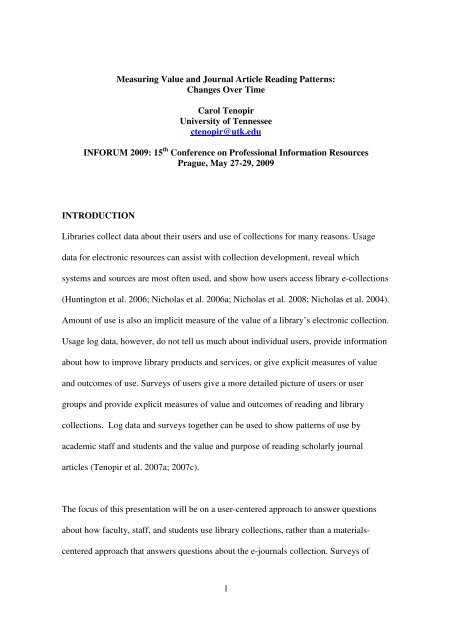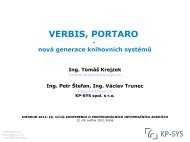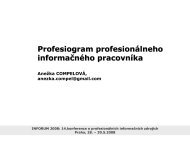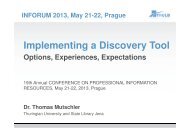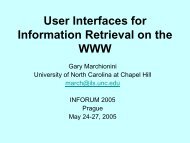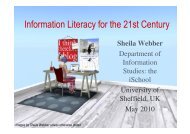1 Measuring Value and Journal Article Reading Patterns: Changes ...
1 Measuring Value and Journal Article Reading Patterns: Changes ...
1 Measuring Value and Journal Article Reading Patterns: Changes ...
You also want an ePaper? Increase the reach of your titles
YUMPU automatically turns print PDFs into web optimized ePapers that Google loves.
<strong>Measuring</strong> <strong>Value</strong> <strong>and</strong> <strong>Journal</strong> <strong>Article</strong> <strong>Reading</strong> <strong>Patterns</strong>:<br />
<strong>Changes</strong> Over Time<br />
Carol Tenopir<br />
University of Tennessee<br />
ctenopir@utk.edu<br />
INFORUM 2009: 15 th Conference on Professional Information Resources<br />
Prague, May 27-29, 2009<br />
INTRODUCTION<br />
Libraries collect data about their users <strong>and</strong> use of collections for many reasons. Usage<br />
data for electronic resources can assist with collection development, reveal which<br />
systems <strong>and</strong> sources are most often used, <strong>and</strong> show how users access library e-collections<br />
(Huntington et al. 2006; Nicholas et al. 2006a; Nicholas et al. 2008; Nicholas et al. 2004).<br />
Amount of use is also an implicit measure of the value of a library’s electronic collection.<br />
Usage log data, however, do not tell us much about individual users, provide information<br />
about how to improve library products <strong>and</strong> services, or give explicit measures of value<br />
<strong>and</strong> outcomes of use. Surveys of users give a more detailed picture of users or user<br />
groups <strong>and</strong> provide explicit measures of value <strong>and</strong> outcomes of reading <strong>and</strong> library<br />
collections. Log data <strong>and</strong> surveys together can be used to show patterns of use by<br />
academic staff <strong>and</strong> students <strong>and</strong> the value <strong>and</strong> purpose of reading scholarly journal<br />
articles (Tenopir et al. 2007a; 2007c).<br />
The focus of this presentation will be on a user-centered approach to answer questions<br />
about how faculty, staff, <strong>and</strong> students use library collections, rather than a materialscentered<br />
approach that answers questions about the e-journals collection. Surveys of<br />
1
academic science, social science, engineering, <strong>and</strong> medical faculty by Tenopir & King<br />
(2000; 2004; Tenopir et al. 2009a) over thirty years show how reading patterns have<br />
changed <strong>and</strong> the changes in usage <strong>and</strong> value of e-article readings. These surveys used the<br />
critical incident technique to focus on specific outcomes <strong>and</strong> values of readings from all<br />
sources in all formats. Four changes that demonstrate value of reading <strong>and</strong> libraries are<br />
presented here.<br />
FINDINGS<br />
1. Faculty members report more readings, less time per reading, but overall a<br />
small increase in total time spent reading. Amount of reading is an implicit<br />
value of reading.<br />
Amount of reading <strong>and</strong> time spent reading are both implicit values of scholarly articles<br />
<strong>and</strong> the sources, such as libraries, that provide access to them. As usage or amount of<br />
reading increases, an increase in value can be implied. Usage logs can be used to easily<br />
measure this implicit value. Implicit value can also be gathered in surveys that ask<br />
questions about amount of use (Tenopir <strong>and</strong> King 2007). The Tenopir <strong>and</strong> King surveys<br />
include several questions that help derive implicit measures of value, including:<br />
• How many articles did you read in the last month?<br />
• For the last article, how much time did you spend reading?<br />
Users show the value of reading because they are willing to pay with their time. For<br />
example, in surveys in five U.S. <strong>and</strong> two Australian universities in 2005, faculty reported<br />
they spend on average approximately 143-159 hours per year reading, while medical<br />
2
faculty members report they spend on average approximately 168 hours per year reading.<br />
This does not include the time spent finding <strong>and</strong> locating articles (King et al. 2009).<br />
Although we cannot claim cause <strong>and</strong> effect, faculty members who report winning awards<br />
in the past two years or who publish two or more articles in the past two years read on<br />
average more than others (Tenopir <strong>and</strong> King 2000).<br />
Over time, the reported number of article readings has increased on average per science,<br />
social science, medical or engineering faculty member. In our latest surveys the average<br />
has increased to 23 articles per month. Projecting to a year (12 months) shows an increase<br />
in reading of approximately 87% since 1977 (from 150 to 280) (Tenopir et al. 2009a).<br />
Although the amount of reading has greatly increased, the exact amount of reading has<br />
always varied considerably by field of science or discipline. For example, medical<br />
faculty consistently over time have relied on journal articles more than any other group<br />
<strong>and</strong> read on average nearly twice as many articles per year as do social science scholars<br />
(Tenopir et al. 2007b). In 2005 the average number of annual article readings by medical<br />
faculty was an estimated 414, compared to 331 for sciences, <strong>and</strong> 233 for social sciences 1<br />
(Tenopir et al. 2009b).<br />
There are many possible reasons for an increase in readings, for example having<br />
electronic access broadens the scope of access for potential articles <strong>and</strong> there are more<br />
1 St<strong>and</strong>ard errors <strong>and</strong> 95% confidence intervals: Medical (27.54, 360-468), sciences (26.79, 279-384),<br />
social sciences (12.24, 209-257.)<br />
3
articles <strong>and</strong> journals published now than in the past, so scholars have to read more just to<br />
keep up with developments in their field. Still, more readings imply a continued <strong>and</strong><br />
increasing use value.<br />
2. Faculty members read from a wider variety of sources <strong>and</strong> use many ways to<br />
get articles. The increase can be attributed to library collections <strong>and</strong> is a<br />
direct value of libraries.<br />
The range of journal titles used has also increased over time. Usage logs show that when<br />
journal titles are made available in library e-collections, reading is highly skewed (most<br />
readings come from a small number of titles), but that the tail is long--at least one article<br />
is downloaded from all or almost all titles that are made available (Nicholas et al. 2006b)<br />
Surveys confirm these findings. In 1977 researchers reported reading on average at least<br />
one article from 13 journal titles. In 1995 that number had increased to 18; by 2003 it was<br />
23 <strong>and</strong> by 2005 it was up to 33 journal titles (Tenopir et al. 2009a).<br />
The increase in journal titles made available in library e-collections is almost certainly<br />
the major reason for this increased diversity. Between 1977 <strong>and</strong> 2005 readings from the<br />
library increased from 37 to 174 per year per person on average, with over 100 of those<br />
from the library electronic collection. Over the same time, readings from personal<br />
subscriptions plunged. The library provides a greater number of readings on average, a<br />
greater variety of sources, <strong>and</strong> plays an important role in e-journal reading. <strong>Reading</strong>s<br />
from print are more likely to be from personal subscriptions, while readings from the<br />
library are more likely to be electronic (Tenopir et al. 2009a).<br />
4
3. Faculty members still read from both print <strong>and</strong> electronic sources. E-<br />
readings are reported as more valuable <strong>and</strong> are more often from libraries.<br />
In surveys from 2000 through 2006 approximately 60% of all article readings by faculty<br />
on average were from electronic sources, with 40% still from print sources. (This refers<br />
to the format of the source, not the form in which it was actually read. A majority of<br />
readings are still printed out on paper for actual reading.) This varies significantly by<br />
subject discipline of the reader, with science faculty reporting a much higher percentage<br />
of their readings from electronic sources (74%) than humanities faculty (29%) (Tenopir<br />
et al 2009b).<br />
The library readings are overwhelmingly from e-collections (74% <strong>and</strong> growing), while<br />
the diminishing numbers of personal subscription readings are still overwhelmingly from<br />
printed journals. Younger readers prefer electronic journals <strong>and</strong> libraries’ e-collections<br />
continue to grow, so this trend will continue (Tenopir et al. 2009b).<br />
In addition, reading of older articles is increasing slightly as more older articles become<br />
available in electronic form. <strong>Reading</strong>s of older articles are more often for research<br />
purposes, more often from the library, <strong>and</strong> are more highly rated as valuable by readers.<br />
4. Faculty members report many purposes <strong>and</strong> explicit values of reading e-<br />
journal articles.<br />
5
<strong>Measuring</strong> the purpose of readings <strong>and</strong> the value of readings to that purpose provide a<br />
more nuanced view of value <strong>and</strong> use of articles than just mere measures of amounts or<br />
patterns of use. Faculty members read for many purposes <strong>and</strong> the purpose of each reading<br />
lends unique characteristics to that specific use. More than half of all readings of<br />
scholarly articles are for research <strong>and</strong> most likely to come from library electronic<br />
collections. <strong>Reading</strong>s for current awareness may come from personal print subscriptions,<br />
while readings for teaching, writing grant proposals, <strong>and</strong> other purposes come from a<br />
variety of sources <strong>and</strong> forms.<br />
Faculty members report many explicit values of readings including, in descending order<br />
of frequency, that the reading:<br />
Inspired new thinking<br />
Improved results<br />
Changed focus<br />
Resolved technical problems<br />
Saved time<br />
Collaboration<br />
Faster completion<br />
Wasted my time (
comments tell qualitative stories of the value that library e-collections bring to users <strong>and</strong><br />
can be more compelling even than quantitative or implicit measures of use. For example,<br />
in our surveys from 2000-2009 faculty members often offer comments such as these:<br />
How did we ever get along without electronic journals?<br />
The ability to obtain articles online has made [my work] much more efficient <strong>and</strong><br />
more thorough.<br />
E-journal access “has increased the strength of my grant proposals … by<br />
allowing for …thorough evaluation of the literature on any particular topic.”<br />
“I have dropped some personal subscriptions as they have become available online.<br />
I rarely visit the library in person anymore… which, compared with the ease<br />
<strong>and</strong> convenience of doing literature searches, downloading <strong>and</strong> printing from my<br />
office/computer, takes too much time.”<br />
Libraries must be careful to measure total use of their collections, as the above quote<br />
shows. Use of electronic collections is much higher than use of print ever was <strong>and</strong> yet our<br />
measures may not have kept pace with this change of usage patterns.<br />
CONCLUSION<br />
In conclusion, measuring reading patterns demonstrates both implicit <strong>and</strong> explicit values<br />
of the library collection <strong>and</strong> e-resources now <strong>and</strong> over time. Usage logs can help with e-<br />
collection decisions <strong>and</strong> show implicit value of e-collections, while surveys with critical<br />
incident can show implicit <strong>and</strong> explicit value of print <strong>and</strong> electronic collections.<br />
7
Studies over time show that reading is increasing, use of e-collections is increasing, <strong>and</strong><br />
the importance of the library is growing. Libraries can demonstrate their value <strong>and</strong> show<br />
those changes over time with accurate <strong>and</strong> ongoing measurements of use <strong>and</strong> usage.<br />
REFERENCES<br />
Huntington, Paul, David Nicholas, Hamid R. Jamali, <strong>and</strong> Carol Tenopir. 2006. "<strong>Article</strong><br />
Decay in the Digital Environment: An Analysis of Usage of OhioLINK by Date<br />
of Publication, Employing Deep Log Methods." <strong>Journal</strong> of the American Society<br />
of Information Science & Technology 57, no. 13: 1840-51.<br />
King, Donald W., Carol Tenopir, Songphan Choemprayong, <strong>and</strong> Lei Wu. 2009.<br />
"Scholarly <strong>Journal</strong> Information-Seeking <strong>and</strong> <strong>Reading</strong> <strong>Patterns</strong> of Faculty at Five<br />
U.S. Universities." Learned Publishing 22, no. 1: 95-113.<br />
Nicholas, David, Paul Huntington, Hamid R. Jamali, <strong>and</strong> Carol Tenopir. 2006a. "Finding<br />
Information in (Very Large) Digital Libraries: A Deep Log Approach to<br />
Determining Differences in Use According to Method of Access." <strong>Journal</strong> of<br />
Academic Librarianship 32, no. 2: 119-26.<br />
———. 2006b. "What Deep Log Analysis Tells Us About the Impact of Big Deals: Case<br />
Study OhioLINK." <strong>Journal</strong> of Documentation 62, no. 4: 482-508.<br />
Nicholas, David, Paul Huntington, Hamid R. Jamali, Ian Rowl<strong>and</strong>s, Tom Dobrowolski,<br />
<strong>and</strong> Carol Tenopir. 2008. "Viewing <strong>and</strong> <strong>Reading</strong> Behaviour in a Virtual<br />
Environment: The Full-Text Download <strong>and</strong> What Can Be Read into It." Aslib<br />
Proceedings: New Information Perspectives 60, no. 3: 185-98.<br />
Nicholas, David, Paul Huntington, Bill Russell, Anthony Watkinson, Hamid R. Jamali,<br />
<strong>and</strong> Carol Tenopir. 2004. "The Big Deal: Ten Years On." Learned Publishing 18,<br />
no. 4: 251-57.<br />
Tenopir, Carol, <strong>and</strong> Donald W. King. 2000. Towards Electronic <strong>Journal</strong>s: Realities for<br />
Scientists, Librarians, <strong>and</strong> Publishers. Washington, DC: Special Libraries<br />
Association.<br />
———. 2004. Communications <strong>Patterns</strong> of Engineers. New York: IEEE/Wiley<br />
InterScience.<br />
———. 2007. "Perceptions of <strong>Value</strong> <strong>and</strong> <strong>Value</strong> Beyond Perceptions: <strong>Measuring</strong> the<br />
Quality <strong>and</strong> <strong>Value</strong> of <strong>Journal</strong> <strong>Article</strong> <strong>Reading</strong>s." Serials 20, no. 3: 199-207.<br />
Tenopir, Carol, Gayle Baker, Eleanor Read, Maribeth Manoff, Kitty McClanahan, David<br />
Nicholas, <strong>and</strong> Donald W. King. 2007a. "MaxData: A Project to Help Librarians<br />
Maximize E-<strong>Journal</strong>s Usage Data." Serials Librarian 53, no. 9.<br />
Tenopir, Carol, Donald W. King, Michael T. Clarke, Na Kyoungsik, <strong>and</strong> Zhou Xiang.<br />
2007b. "<strong>Journal</strong> <strong>Reading</strong> <strong>Patterns</strong> <strong>and</strong> Preferences of Pediatricians." <strong>Journal</strong> of<br />
the Medical Library Association 95, no. 1: 56-63.<br />
8
Tenopir, Carol, Eleanor Read, Maribeth Manoff, Gayle Baker, David Nicholas, <strong>and</strong><br />
Donald W. King. 2007c. "What Does Usage Data Tell Us About Our Users?" In<br />
Online Information 2007 Conference Proceedings 80-86. London: Incisive<br />
Media.<br />
Tenopir, Carol, Donald W. King, Sheri Edwards, <strong>and</strong> Lei Wu. 2009a. "Electronic<br />
<strong>Journal</strong>s <strong>and</strong> <strong>Changes</strong> in Scholarly <strong>Article</strong> Seeking <strong>and</strong> <strong>Reading</strong> <strong>Patterns</strong>." Aslib<br />
Proceedings: New Information Perspectives 61, no. 1: 5-32.<br />
Tenopir, Carol, Donald W. King, Jesse Spencer, <strong>and</strong> Lei Wu. 2009b "Variations in<br />
<strong>Article</strong> Seeking <strong>and</strong> <strong>Reading</strong> <strong>Patterns</strong> of Academics: What Makes a Difference?"<br />
Library & Information Science Research 31, no. 3.<br />
9


